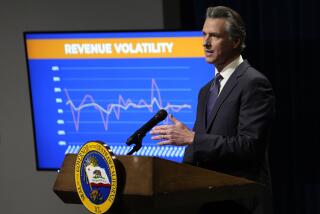Yo-Yos and Taxes
- Share via
The Deukmejian Administration has made a rush to judgment on the cause of an estimated $2-billion shortfall in state tax revenue and is jumping into a crash recovery program that includes $400 million in budget cuts. Gov. George Deukmejian should take a closer look at the problem before leaping to a solution.
Deukmejian and Jesse Huff, his finance director, are blaming the shortfall on legislative changes in 1987 designed to make the state tax system conform with the 1986 federal tax reform. But there is evidence that a major reason for the big dip in tax revenue is poor estimating by Huff’s Finance Department combined with a miscalculation of the effects of the stock-market crash last October.
Huff believes that this year’s $1-billion shortfall will occur again in the new fiscal year beginning July 1 because of calculating errors in the state conformity legislation. Not all state fiscal experts agree. Chairman John Garamendi (D-Walnut Grove) of the Senate Revenue and Taxation Committee said that the legislation alone could not have had such a dramatic effect on tax collections. The error would have to be from bad estimates provided by the Deukmejian Administration’s Finance Department, he said.
Garamendi’s view is supported by a report compiled by the Policy Economics Group, the Washington consulting firm that provided the computer modeling on which the state adjusted its tax laws to conform with federal changes. The firm was founded by former experts of the Treasury Department and Congress’ joint taxation committee who wrote the federal tax-reform law.
The Policy Economics Group said that about 90% of the shortfall this year could be the result of incorrect estimates of revenues coming to the state from the capital-gains tax. The state assumed a substantial increase in capital gains in 1987 because of the frenzied trading on Wall Street last fall, but there is evidence that losses may have been as high as the gains, the Policy Economics Group told the state in a report dated May 14.
Further, the Policy Economics Group says that the $1-billion shortfall may not be repeated in the coming fiscal year as Huff predicted. There still may be a falloff in capital-gains taxes, but it could be largely offset by other revenue increases, leaving a deficit of perhaps $200 million for 1988-89. A sign that this approach may be right was the governor’s decision Thursday to increase estimates of revenue for 1988-89 by $500 million because of a suddenly brighter economic outlook.
One factor that is confusing the issue, the experts in Washington say, is that California is not able to make the new revenue estimates on a fiscal-year basis. The state may be able to forecast the total effect of the state tax-law changes for all of the calendar year of 1988, but it is not certain how to break down the revenue flow between the current fiscal year ending on June 30 and the new year begining on July 1. The state reform was designed to be revenue neutral by balancing some tax increases against other tax reductions. As it happens, though, tax reductions tend to show up first because of changes in payroll withholding. Higher income resulting from revenue increases tends to lag.
Some of the tax experts in Sacramento say that the state does not have an adequate economic model for estimating its revenues in normal times, even without dramatic changes in federal and state tax law and complications like last October’s stock-market crash. If so, this is a basic flaw in California’s entire revenue system, and it should be corrected.
Last year the state gave back $1.1 billion to taxpayers because of an unexpected windfall. Now the pendulum has swung the other way, and the governor is talking about big budget cuts and a corporate tax increase. California cannot have a rational budget process if this yo-yo effect continues. The situation also highlights again the folly of the Gann spending limits that could inhibit the state’s ability to make up the revenue shortfall, should it actually turn out to be a full $2 billion.
More to Read
Get the L.A. Times Politics newsletter
Deeply reported insights into legislation, politics and policy from Sacramento, Washington and beyond. In your inbox twice per week.
You may occasionally receive promotional content from the Los Angeles Times.










